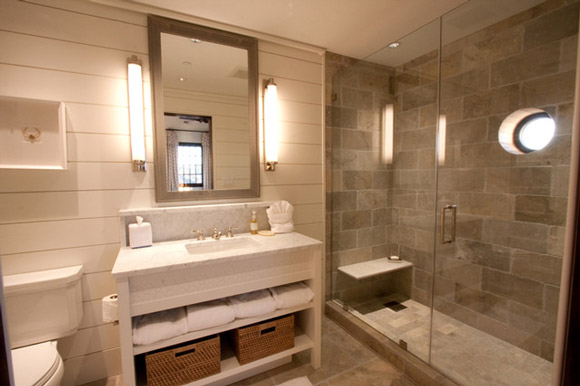It goes without saying that the layout of the tiles is king in any bathroom building or renovation project. This is why planning the tile layout very carefully from the start can help with everything from framing all the changes you want in niche locations to installing all the right fixtures in their respective locations. If you do not plan your layout carefully your results will not be perfect. When building a bathroom and choosing tiles its best to follow a few tried and tested words of advice.
Plan everything ahead of Time
Your bathroom needs to be planned ahead of time. Things like showers, bath tubs, wash basins etc all need to be planned so that the tiles can be laid out accordingly. At times some custom framing will be needed to achieve this look. Take other details like down-lights, medicine cabinets and fans into consideration before you start thinking about tiles.
Do not assume the Size
The single biggest mistake that many people who are renovating their bathroom for the first time make is that they assume the tile sizes. For instance they will assume it’s a 12 x 24 inch tile when in fact it a bit larger. The vast majority of bathroom tile Sydney is sold in European sizing where the standard is around 30 centimeters by 60 centimeters. You can factor in the grout joint too so the size of the tile can be nearer to around 11 3/8 inches. Make sure to purchase a sample of the tiles that you want and then lay them out, also check to see if they have been soak tested.

Lay Bathroom tiles downwards from the Ceiling
There are many shower niches which end up looking ugly because they have cut tiles but you can prevent this from happening. You need to start laying down the pattern from the beginning so that later the mitered pieces will start on the correct grout joint. When you lay the pattern from the finished ceiling height it will make it easier to do it correctly. If it makes things easier draw the design on a wall board before waterproofing to ensure that the layout is correct before you install the tile. If you see that the wall studs are hindering the plumbing fixtures from being properly placed where you need them address it right away.
Be very careful when laying down tiles around Doors and Windows
Laying out tiles across your doors and windows is very critical. Every door and window has its own set of challenges and also waterproofing the assembly can prove to be challenging. The best thing to do is to make sure that your shower or bath’s waterproofing system has been designed with the windows in mind. This will ensure that water does not get behind the tile and go into the window framing. Having properly tilted sills and some room for expansion will ensure that the tiles properly hold up for many years.
Pay close attention to Pebbled Floors
When you are designing showers that have a river rock floor always remember that they drain slower. You can speed things up by increasing the pitch slightly and using epoxy grouts which can help quickly dry out the bathroom in between showers. It is strongly advised not to build a pebble shower floor that has a pitch of less than 2% or around 1/4 inch per foot.
Cure in between steps
Sealing tile and using natural stone can enhance a number of different tiles. A good practice would be is to prepare a sample tile board, then seal it prior to sealing the entire shower or bathroom all of which needs to be done prior to installing a floor tile. It is important to stay off these floors until they have been fully cured and wait as long as needed prior to sealing the tiles.
Detail does make a difference
When laying down bathroom tiles you need to pay close attention to the corners where the tile has been pushed around the edge. Good attention to detail and design will make these areas look good and polished.
Bigger niches are easier to tile
Try to design bigger niches. First decide on what it should measure then build the shower niche around 1 to 2 inches bigger. This will allow for a bit of adjustment in order to align everything with the tile’s grout.
Citations:
- How to Hire a Tiling Contractor
Mark has been an interior designer for over fifteen years. He has practiced interior design at some of the leading institutions in the world. He has written a number of books on the subject and continues to teach newbie interior designs. In addition his blog serves regular people with a daily dose of how-to’s and advice.
